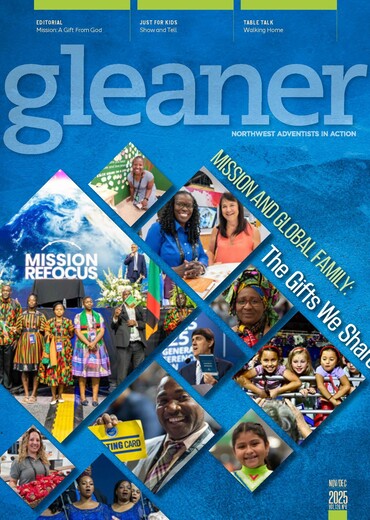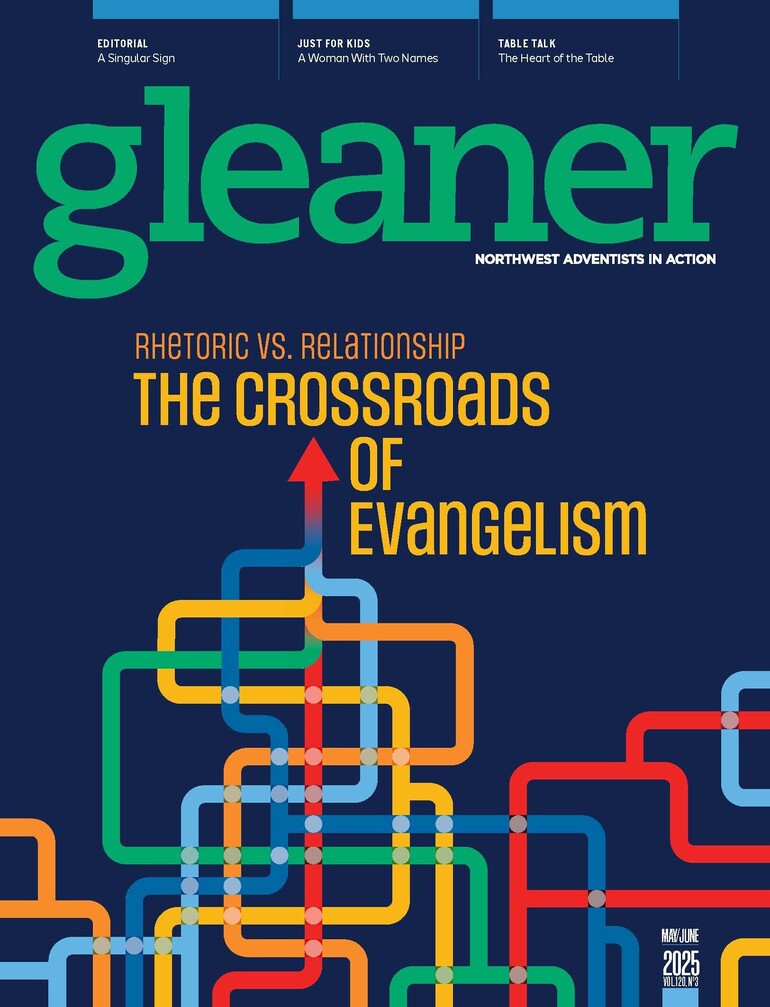Imagine two church board meetings happening at the same time. These two churches, both well-attended and deeply rooted in Adventist tradition, are separated only by a few miles. As they gather to discuss evangelism, the approaches diverge in unexpected ways.
In the first meeting, one board member — an elder — remarks that due to the poor turnout of the last food drive two years ago, the evangelism budget should instead go toward more traditional efforts, like a concert or seminar series. Installing a micro-pantry as an extension of the food drive, they argue, would require constant supervision and maintenance and could become inconvenient. No one mentions that the previous food drive was only advertised in the church bulletin.
Meanwhile, at the second church, the board consists of members from different walks of life and ages. They eagerly discuss ways they can partner with the local homeless shelter and make plans to use the church as a warming station come winter.
One board member shares that someone who regularly visited their food pantry attended their Bible study the following week. Another mentions that a person who frequents the pop-up dental clinic recently asked the chaplain for prayer and wanted to talk about Christianity.
These two conversations take place in our churches regularly, and, in each one, we expose our expectations of evangelism — expectations that are deeply influenced by the communities around us, our experiences and sometimes our fears.
The word "evangelism" has become a conflicting term in recent years. While the Great Commission is ingrained in our collective thinking, calling us to share the gospel, the practical reality of evangelism can feel uncertain. When the moment comes to share, we might hesitate, unsure which approach to take or if we should take any action. Do we lean into polished rhetoric? Do we lean into authentic, relational connection? Is it about blending both? What’s the right approach?
Perhaps fear holds us back — fear of saying the wrong thing or not knowing how to answer tough questions. Maybe it's worry about how we’ll be perceived — could talking about faith make a conversation awkward or risk straining a friendship? These uncertainties often leave us frozen at a crossroads, unsure of how to step forward in faith.
Evangelism, at its core, has a dual purpose. It's both proclamation and connection, both speaking the truth and living it out. No single method is the "right" way — what truly matters is a willing heart and openness to God’s leading.
Let’s look at how the crossroads of life and faith bridge the past, present and future through intentional relationships and the art of using everyday language to inspire and influence others.
Historical Example
By necessity and through a deep sense of urgency, our Adventist pioneers blended personal, public and practical evangelism in ways that helped establish the foundation of our church today.
Consider the story of Augusta Moorhouse, the first known Adventist in the Walla Walla territory. After accepting the Sabbath truth at tent meetings in Iowa, she was swept away by her husband to a location where there were no other Adventists.
For seven years, she prayed for the opportunity to find another believer who shared her faith. One day, she learned of a Seventh-day Baptist family — the Stephen Maxsons — living nearby, so she saddled her horse and visited them.
Over time, her repeated visits to the family made an unexpected impact. James Franklin Wood, the Maxsons’ son-in-law and local school superintendent, was so unsettled by Moorhouse’s direct and persistent evangelism that he decided to move his family hundreds of miles away in an attempt to escape her “meddling.”
Ironically, they settled next door to an Adventist family in Windsor, California. There, after attending tent meetings, Wood encountered Adventist teachings again and embraced the Sabbath message.
Convicted by his newfound beliefs, Wood returned to Walla Walla to share the message with his former neighbors. While his beginning efforts had meager results, his persistence marked the beginning of Adventist growth in the region.
Early Northwest Adventists had plenty of their own problems to navigate: false teachings, interpersonal conflict and even financial mismanagement. When they aligned their hearts with God and one another, the church grew and multiplied.
As the church grew, church planting through traveling tent meetings and literature evangelism helped expand a network of Adventist believers across Walla Walla, the Upper Country, Oregon's Willamette Valley, western Washington, Idaho's Treasure Valley, Montana and Alaska.
These early stories of evangelistic grace and growth are detailed in Adventism on the Northwest Frontier by Doug R. Johnson, which chronicles the expansion of the Adventist Church before its formal organization into the structure we know today.
Just as Adventist pioneers adapted their methods to the unique challenges of the frontier, we too have the opportunity to engage with people in a way that is culturally sensitive, relational and attuned to life’s struggles and joys.
Insights From Scripture
Scripture offers a rich tapestry of evangelistic approaches, shaped by different personalities, circumstances and cultures.
The woman at the well immediately shared her testimony after encountering Jesus. Her personal experience became an invitation: “Come, see a man who told me everything I ever did!” (John 4:29). Her boldness in sharing her encounter led many in her town to seek out Jesus for themselves.
In contrast, Martha demonstrated evangelism through the behind-the-scenes gift of hospitality. By welcoming Jesus, His disciples and her community into her home, she created a space where people could experience the gospel through acts of kindness and fellowship (Luke 10:38–42).
Philip took a different approach, ministering to people in their daily lives. His encounter with the Ethiopian official on the road in Acts 8:26–40 was a divine appointment — one that required attentiveness and readiness to respond. His willingness to explain scripture led to an immediate decision for baptism, illustrating how evangelism often happens in personal, unexpected moments.
Paul, a relentless missionary, adapted his approach to different audiences. In synagogues, city centers, homes and even prison cells, he preached the glad tidings of Christ (Acts 13–14). Sometimes he reasoned through scripture; other times, he built relationships and met people where they were. His adaptability underscores that evangelism is about following the Spirit’s leading, not a rigid formula.
Despite their differences, these biblical figures had one thing in common: relational intentionality. Whether through public proclamation, hospitality, personal conversations or missionary journeys, their witness flowed from a heart transformed by Christ and a deep commitment to sharing His message with everyone around them.
Christ’s Model
At the heart of all evangelism is Christ Himself. Jesus didn’t confine His ministry to synagogues or formal teaching settings. Instead, He met people where they were — on dusty roads, at dinner tables, by fishing boats, on mountainsides and in crowded marketplaces.
His approach wasn’t transactional or agenda-driven. He listened before He spoke, healed before He called and built trust before He invited people to follow Him. He saw individuals, not just audiences, and led with compassion.
Ellen White, Adventist Church co-founder, wrote in Ministry of Healing, page 143, “Christ’s method alone will give true success in reaching the people.”
This commonly quoted method — mingling with people, showing sympathy, meeting needs, winning trust and then inviting them to follow Him — remains the foundation of effective evangelism.
Northwest ministry leaders emphasize that true evangelism is still rooted in genuine relationships that naturally lead to deeper conversations about faith and heart transformation. Without authentic connection, rhetoric alone falls short. It doesn't nurture long-term discipleship or lasting spiritual growth.
“This counsel is not given for a specific culture, time or generation; it's the only method, according to White, that will work,” said Peter Simpson, North Pacific Union vice president for Hispanic ministries and ministerial director. “More than talking about religion, we need to demonstrate it; more than discussing ‘beliefs,’ we need to show them. Getting closer to people and showing them love is how we can bring them closer to God.”
Eric Brown, Upper Columbia Conference ministerial director, echoed this thought: “The reason Jesus came was to build a relationship with people, not just to do nice things for them. He gained their trust to allow for deeper conversations to take place.”
Brown continued, “If in the process we are meeting [physical] needs but viewing people as projects, then we aren’t following Christ’s model. A lot of churches like being nice people but don’t like to engage in relationships with people with whom they disagree or maybe with whom they don’t identify. We must enter into our evangelism with humility and equality, not superiority.”
As David Jamieson, UCC president, often quips, “Methods are just methods until we allow the heart to show up.” Evangelism isn’t just about the programs or events we put on; it’s about the hearts that engage with others and the authenticity behind every action. Without this heart connection, the methods fall flat.
Missionary Mindset
Evangelism today continues to be at a crossroads. Over the last century, evangelism became an institutionalized work of paid clergy, but the reality is that evangelism is still a communal responsibility.
Evangelism still is not a one-size-fits-all model because what works in one place may not work in another. Reaching people effectively requires the time to listen, learn and adapt our methods — whether through digital outreach, community events or one-on-one conversations. This flexibility is key.
A group of Northwest Adventist pastors and leaders recently participated in an internationally-attended church planting conference. Their key takeaway? Too often, church members are passive consumers. When relational discipleship happens — doing life with people as Jesus did — movement begins, churches are revitalized and churches are planted.
All forms of evangelism remain relevant. “When you do a public evangelistic series, on average, 80–90% of people who make the decision already have some kind of connection to the local church,” noted Tyler Long, Washington Conference personal ministries director and evangelism coordinator.
Barna researchers identified a rising spiritual openness, especially among young people. In 2022, 59% of Gen Z and 54% of Millennials reported being more open to God today than before the pandemic.
Outreach, especially to younger generations, thrives on genuine connections where faith grows naturally through honest questions, shared stories and met tangible needs. Evangelism isn’t about perfect answers; it's about walking alongside people, fostering conversation and allowing God to work. It should prioritize relationships over arguments and community over condemnation because the gospel offers more than ideas — it offers belonging.
“Evangelism is active,” reminded Chris Evenson, Nampa Church pastor, whose church recently purchased a community service building to intentionally walk alongside 130–160 people per week. “We are called to take care of our community physically and spiritually.”
Relational evangelism is already present in humanitarian aid, healthcare, education, small groups and personal outreach. While fear may arise, it can fuel bravery, leading us to engage with openness and boldness. When we seek divine appointments, new doors open — not through perfect persuasive speech, but through genuine relationships, deep care and space for the Holy Spirit to work.
Dan Serns, NPUC church planting and lay training director, has adopted the BELLS model of evangelistic living — Bless others, Eat together, Listen to the Spirit, Learn Christ and understand yourself as Sent by God into others’ lives to spread the gospel organically, graciously and surprisingly.
“I ask God for divine appointments every day,” Serns said. “Knowing that Jesus is coming soon and people need to know that Jesus loves them and will change their lives if they let Him gives me daily purpose.”
Through his “Mobilizing for Mission” weekend trainings, Serns often encounters evangelism myths such as that it's optional for a believer, that it’s only for professional evangelists or pastors, that public evangelism no longer works or that some forms of evangelism are better than others.
“People think evangelism is some complicated formula; it's simply sharing ‘good news,’” Serns said. “In reality, almost anything that is done with Jesus in your heart will result in effective evangelism.”
Recent data from eAdventist shows a promising shift in the vitality of Adventist churches in North America. Since 2024, 31% of churches are growing, a significant increase from just 16% in 2017. Meanwhile, the percentage of declining churches has decreased from 65% to 57%, and plateauing churches have dropped from 19% to 12%. This positive trend reflects the energizing effect of regular baptisms, discipleship and transformed lives within congregations.
“God is raising up people to respond to the desperate needs of society,” Serns said. “Most people respond well to genuine people who care about others. That’s why we need missional living.”
Our Continual Crossroads
Evangelism will always be at a crossroads — where lives intersect, decisions are made and hearts are invited to turn toward Jesus.
For too long, it has been seen as the work of a few rather than the mission of all. But true evangelism isn’t about polished programs or perfect rhetoric, it’s about relationships. It’s about meeting people where they are, listening before speaking and creating spaces where faith can grow naturally.
The gospel is not just an idea to be debated, but a life to be shared. Whether through digital outreach, community service or everyday conversations, we are called to engage — not as passive consumers, but as active disciples.
The world needs authentic witnesses — those willing to cross the road and meet others where they are. Trust that God will lead you, take a step of faith and move forward on this journey of relationship-building and gospel-sharing.
The message of Jesus is timeless, but how we share it must be as dynamic and responsive as the world around us. May we move forward with compassion, humility and the deep conviction that, no matter the method, the heart of evangelism is always about relationships built on trust and love.
As we embrace the opportunities before us, may we be faithful in extending the invitation, guiding others to take that next step in faith. Who in your life is standing at a crossroads, waiting for a word of hope? Now is the time to invite them to turn the corner and follow Him.*
* Nicole Dominguez, freelance writer, contributed to the introduction and conducted three interviews.









